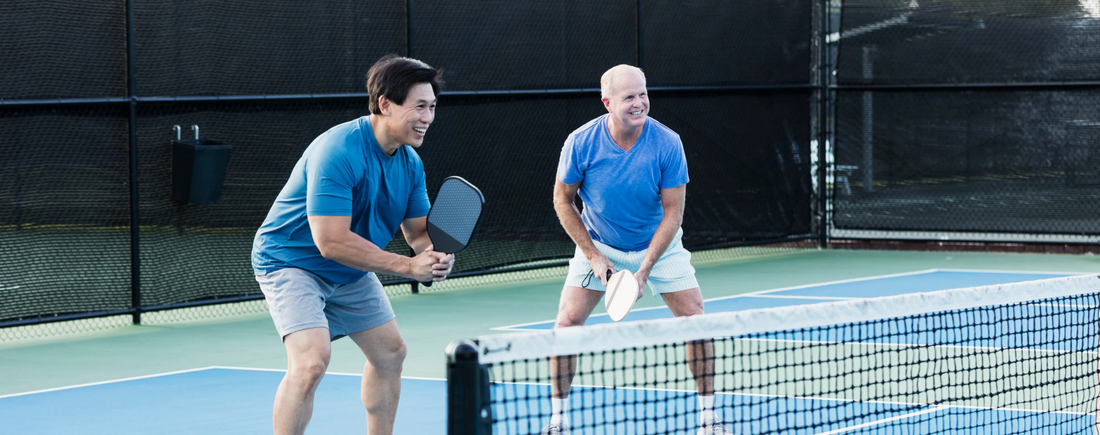
Court Chemistry: How to Build Synergy with Your Doubles Partner
Share
Doubles pickleball is more than a two-on-two match. It’s a symphony of timing, trust and nonverbal understanding. While individual skill is undeniably valuable, true dominance in doubles hinges on the intangible force known as court chemistry.
It’s what allows partners to move in unison without a word. To anticipate each other’s choices. To recover from mistakes without drama and celebrate small victories with shared energy. Whether you’re competing at tournaments or battling friends for post-game bragging rights, building synergy with your doubles partner can elevate your game from decent to devastating.
This article delves into the nuances of developing that elusive but essential connection with your pickleball partner and outlines the habits and strategies top-performing pairs swear by.
Communication: The Cornerstone of Connection
Successful doubles teams don’t just play together. They communicate constantly — before, during and after the match.
Pre-match dialogue should include:
- Shot preferences (forehand vs. backhand dominance)
- Preferred positioning (do they favor the left or right side?)
- Strategic tendencies (aggressive at the net or patient with dinks?)
- Verbal cues (What terms will you use for switches, poaches, or lobs?)
In-match chatter must be clear and efficient. Calls like “Mine,” “Yours,” “Switch,” or “No” should be second nature. Good partners also offer real-time encouragement and reset tone after errors.
Post-match debriefs are often overlooked but invaluable. Discuss what worked, what felt off, and how to improve next time. Synergy thrives on reflection.
Role Definition: Knowing Your Job on the Court
Doubles teams function best when each player understands their role. This doesn’t mean locking players into rigid tasks but rather assigning responsibilities based on strengths.
Typical role divisions may look like:
- One player controls the kitchen and initiates dinks
- The other excels in baseline drives and third shot drops
- One is a strategic poacher with lightning-fast reflexes
- The other plays the anchor role, controlling tempo and coverage
Establishing these tendencies helps prevent overlap and hesitation. When both partners trust who’s covering what, court movement becomes instinctive instead of reactive.
Movement Synchronization: Flow Like a Unit
One hallmark of great doubles teams is coordinated court movement. The concept of “shading” or “stacking” isn’t just for pros — it’s foundational for synergy.
Key movement principles include:
- Lateral Mirroring: If one player shifts left, the other adjusts right to maintain coverage
- Zonal Awareness: Recognize your quadrant and respect your partner’s space unless intentionally switching
- Stacking Strategy: Use stacking formations to optimize forehand use and strategic return setups
- Covering Poaches: If your partner goes for a poach, immediately shift to protect their vacated space
Practicing movement together can dramatically reduce errors from collisions or uncovered shots.
Shot Selection Synergy: Harmonizing Styles
Every player has their go-to shots, but synergy requires adapting to each other’s rhythms. It’s not just about what shot you hit, but how it flows with your partner’s pattern.
Align your styles by:
- Matching dinking tempo — don’t accelerate when your partner is playing soft
- Using cross-court dinks to pull opponents wide, setting up your partner’s poach
- Coordinating third shots and resets — one soft reset is better than two simultaneous drives
- Planning offensive sequences — if one player sets up an attack, the other should be ready to finish
Shot harmony creates predictable rhythm for your team and unpredictable patterns for your opponents.
Emotional Intelligence: The Invisible Edge
Your attitude on the court can either empower or unravel your partnership. The best doubles teams treat each other with mutual respect, patience and trust, regardless of the scoreboard.
To strengthen emotional synergy:
- Avoid blame language after errors. A simple “We’ll get the next one” keeps morale intact
- Recognize body language. A slumped shoulder or forced smile may signal stress — check in
- Celebrate smart decisions, not just successful outcomes
- Stay positive under pressure. Confidence is contagious
A supportive partner can transform a bad day into a good performance and a close match into a comeback.
Practice Together, Not Just Play Together
Chemistry doesn’t happen by accident. It’s forged through reps, trial and adaptation.
Doubles-specific practice ideas include:
- Kitchen line dinking duels with roles reversed
- Third shot drop drills with switching coverage
- Shadow movement drills with no ball, just footwork
- Simulated point construction focusing on team communication
- Reviewing match footage together to analyze court spacing and coordination
The more you rehearse together, the more you start to move and think as one.
Conclusion: The Partnership is the Power
In the world of doubles pickleball, individual skill gets you started, but partnership wins championships. Court chemistry is not mystical — it is the result of deliberate practice, shared strategy and mutual respect. When cultivated properly, it transforms two players into a single cohesive force.
So next time you step on the court, look beyond your own paddle. Listen. Move with intent. Play with trust. Because in doubles, greatness is never a solo act. It’s a duet of discipline and connection that plays out in perfect harmony.












